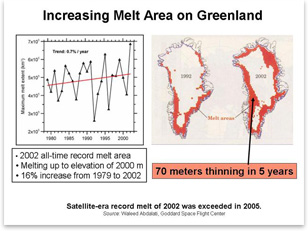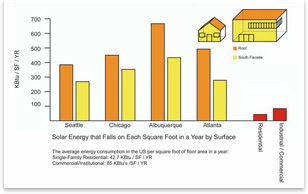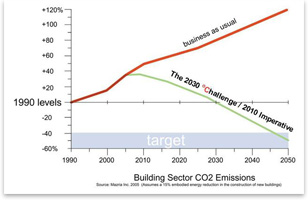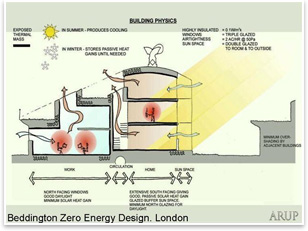
|
Teach-In Defines “Catalyzing Moment” for Environmental Action
February 20 Webcast unites professionals and educators in the “2010 Imperative”
Why a teach-in?: Susan Szenazy, editor of Metropolis magazine and moderator for the teach-in, defined its purpose as “bringing design education into harmony with the Earth that gives us life.” The teach-in delivered her promise of giving students and educators access to useful information and a Web of connections to like-minded individuals, and professionals a network of shared information as they “take on the mantle of educating the next generation.” “A Threat to the Planet” He offered two scenarios:
Hansen presented the United Nations framework for stabilizing emissions, which offers three major measurements for dangerous climate change: Animal and plant species: In the Business as Usual scenario, with 3 degrees C warming, there will be extinction of 50 percent of species; with 1 degree warming, there will be 10 percent extinction. Ice sheet disintegration and resultant rise in global sea levels: The edges of ice sheets already are disappearing, witnessed clearly in Greenland and Antarctica. With an increase of 3 degrees C, the ocean level will rise 80 feet.
Even a one degree rise risks a different planet from the one on which we now live, Hansen explained. Reducing the emission of greenhouse gases to achieve that one-degree level will require a concerted effort, but it can be done. Actions taken in response to the 1970s Energy Crisis resulted in a noticeable drop of CO2 emissions, which put us on the Business as Usual track we’re currently on. (Yes, it was worse 30 years ago). Further reductions can be achieved through:
There is still time, but a decade more of continuing on the Business as Usual path will eliminate the possibility of achieving the 1 degree C scenario. “The best hope we have is the younger generation becoming informed and involved,” Hansen concluded.
But how? Adopt and implement the 2030 challenge, Mazria says. It calls for:
The U.S, Conference of Mayors already has adopted this challenge, Mazria pointed out.
Government. For its part, the federal government can:
Additionally, local governments can provide additional incentives and modify locally adopted codes to establish a 50 percent energy reduction target. Schools: Schools also must transform, Mazria said. “Beginning in 2007, all projects must be designed to engage the environment in a way that dramatically reduces or eliminates the need for fossil fuels.” Specifically, we need to:
“We need to take action,” Mazria concluded. “And there’s plenty of action to take.”
Luebkeman offered the audience a set of working assumptions:
More about the projects can be found on ARUP’s Web site. Buildings are 50 percent of the problem, Luebkeman reminded the audience, so decide how you can make a difference. Set a target for yourself and “reduce, reduce, reduce.” He said that we need to think about how we are going to use energy. For instance, we need to understand that “personal mobility does not equal freedom” and also that “you vote by what you buy.” And remember, he concluded, that “waste is just nothing less than a misallocated resource.” |
||
Copyright 2007 The American Institute of Architects. All rights reserved. Home Page |
||
news headlines
practice
business
design
Recent related
› Five Projects Awarded for Smart Growth
› AIA Launches “Blueprint for America”
› Smart Growth: Building Livable Communities (PDF) – [This is the public policy statement]
Do yourself and the planet a favor and watch the archived Webcast.
Architecture 2030 was established in response to the global-warming crisis by Edward Mazria, AIA, in 2002. Locally, nationally, and globally, Architecture 2030 has been responsible for reshaping the debate surrounding climate change and greenhouse gas (GHG) emissions to define and include a Building Sector. Architecture 2030's mission is to rapidly transform the U.S. and global building sector from major contributor of GHG emissions to a central part of the solution to the global-warming crisis.
Captions:
Image 2. Greenland offers a clear example of ice melt.
Image 3. With the “Business as Usual” scenario, 50 percent of existing plant and animal species may disappear by the end of the century.
Image 4. Even Seattle, one of the cloudiest locations in the U.S. receives enough solar energy for a 0-percent carbon solution.
Image 5. The 2030 Challenge could drastically reduce carbon emissions from buildings.
Image 6. Sketch shows how ARUP’s Beddington Zero residential units use
passive solar for heating and cooling.
Sponsors for the 2010 Imperative
Platinum
The American Institute of Architects (AIA)
The Home Depot Foundation
US Green Building Council (USGBC)
New York Academy of Sciences
Gold
Rockefeller Brothers Fund
Silver
AIA Large Firm Roundtable
Supporters:
AIA NYC
AIA Committee on the Environment
Skidmore, Owings & Merrill LLP
Metropolis magazine
AIA Students
Society of Building Science Educators
Association of Collegiate Schools of Architecture
Union Internationale des Architectes
Royal Architecture Institute of Canada
American Solar Energy Society
Jonathan Rose Companies LLC
Turner Construction
National Wildlife Federation
BuildingGreen, Inc.
D+Arquitectos.

 Summary:
Summary:
 “Resuscitating a Dying World (2030 Challenge/2010 Imperative)”
“Resuscitating a Dying World (2030 Challenge/2010 Imperative)”

